
Spacemaker@Mic~we Own
Contents
Mode1~130J
The el~tric output of this microwave oven is 750 watk~
GEAppLancm

Spacemaker@Mic~we Own
Contents
Mode1~130J
The el~tric output of this microwave oven is 750 watk~
GEAppLancm
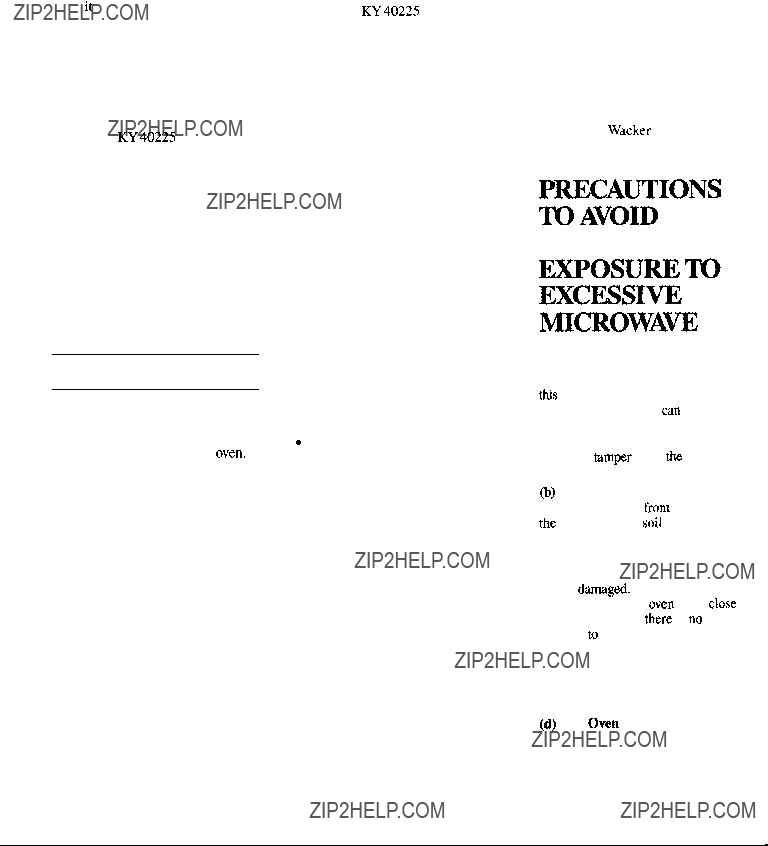
Help whelp you...
Before using your oven, read this book carefully.
It is intended to help you operate and maintain your new microwave oven properly.
Keep it handy for answers to your questions.
If you don???t understand something or need more help, write (include your phone number):
Consumer Affairs GE Appliances Appliance Park Louisville. KY40225
Write down the model and serial numbers.
You???ll find them on a label inside the oven on the upper left side.
These numbers are also on the Consumer Product Ownership Registration card that came with your microwave oven. Before sending in this card, please write these numbers here:
Model Number
Serial Number
Use these numbers in any correspondence or service calls concerning your microwave oven.
Be sure your microwave oven is registered.
It is important that we know the location of your microwave oven should a need occur for adjustments.
Your supplier is responsible for registering you as the owner.
Please check with your supplier
to be sure he has done so; also send in your Consumer Product Ownership Registration Card. If you move, or if you are not the original purchaser, please write to us, stating model and serial numbers.
This appliance must be registered. Please be certain that it is.
Write to:
GE Appliances
Range Product Service
Appliance Park
Louisville. KY40225
If you received a
damaged oven...
Immediately contact the dealer (or builder) that sold you the oven.
Save time and money.
Before you request service . . .
check the Problem Solver on page 28. It lists causes of minor operating problems that you can correct yourself.
All these things are normal with your microwave oven.
???Steam or vapor escaping from around the door.
???Light reflection around door or outer case.
???Dimming oven light and change in blower sound may occur while operating at power levels other than high.
c Dull thumping sound while oven is operating.
??? Some
If you need service...
To obtain service, see the Consumer Services page in the back of this book.
We???re proud of our service and want you to be pleased. If for some reason you are not happy with the service you receive, here are three steps to follow for further help.
FIRST, contact the people who serviced your appliance. Explain
2
why you are not pleased. In most cases, this will solve the problem.
NEXT, if you are still not pleased,
write all the
Manager, Consumer Relations
GE Appliances
Appliance Park
Louisville, Kentucky 40225
FINALLY, if your problem is still not resolved, write:
Major Appliance
Consumer Action Panel
20 North Wacker Drive
Chicago, Illinois 60606
PWAUTIONS
POSSIBLE
HCESSIVE
ENERGY
(a) Do Not Attempt to operate this oven with the door open since
m) Do Not Place any object between the oven front face and the door or allow soil or cleaner residue to accumulate on sealing surfaces.
(c) Do Not Operate the oven
if it is damagd. It is particularly important that the oven door close properly and that there is no damage to the:
(1)door (bent)
(2)hinges and latches (broken or loosened)
(3)door seals and sealing surfaces.
(d) The Oven Should Not be
adjusted or repaired by anyone except properly qualified service personnel.
???
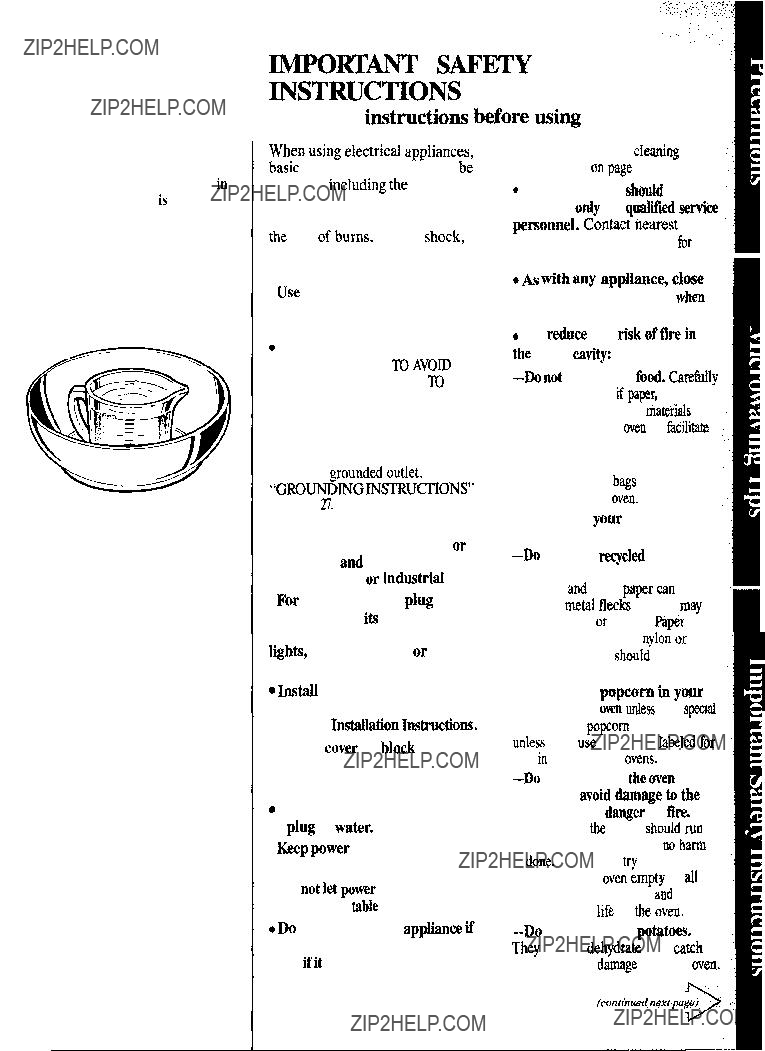

WO~NT S~E~ mSmUCTIONS
(Continual)
* Use meti o~y as dimted in M Wk. TV dinners may he microwaved in foil trays 10ss than 3/4?????? h@; remov~ top foti cover and return tray to box. men wing meti in the microwave oven, keep meti (other than rn- shelfi at
??? Cookware may become hot
* *m&tkes, the oven floor w
tim$too hot to touch. Be careM touching the floor during and ~er cooking,
??? Foods cooked in liquids (such as pasta) may tend to boil over mom rnpidly than m co- less moisture. Should this occur, &r to p~e 25 for instructions on how to clean the inside of the oven.
*
@ Plwtic cookwar*Plastic cookware designed for microwave cooking is very useful, but should be used carefi~y. Even microwave- safe plastic may not be as tolerant of overcooking conditions as are glass or ceramic materials and may safien or char if subjected to short periods of overcooking. In longer exposures to overcooking, the food and cookware could ignite. For these reasons: 1) Use
* When cooking pork, follow the directions exactly and always cook the meat to an internal temperature of at least 170W, This assures that, in the remote possibility that trichina may be present in the meat, it will be killed and meat wfil be safe to eat.
* Do not bofl eggs in a microwave own. Pressure wdl budd up inside egg yolk and will cause it to burst, possibly resulting in injury.
??? Foods with unbroken outer
???%kins~??? such as potatoes, sausages, tomatoes, apples, chicken livers and other giblets, and egg yolks, (see previous caution) should be pierced to allow steam to escape during cooking.
??? Not W plastic wrap is suitable for use in microwave ovens, Check the package for proper use.
. $~Boilab]e??? cooking Wuchm
and tightly closed plastic bags should be slit, pierced or vented as directed by package. If they are not, plastic could burst during
or immediately after cooking, possibly resulting in injury. Also, plastic storage containers should be at least part~y uncoveti because they form a tight seal. men cooking with containers tightly covered with plastic wrap, remove covering carefilly and direct steam away from hands and face.
. spon~neous
4

THE EXHAUST HOOD
??? Have it installed and properly grounded by a qdfied instier. See the special instigation booHet packed with the microwave oven.
. The exhaust fan in the oven W operate automatictiy under certain conditions (see htomatic Fan Feature, page 6). mile the fan is operating, caution is required to prevent the starting and spreading of accidenti cooMng fires while the exhaust fan is in use. For this reason:
SAVE THESE
INSTRUCTIONS
Optional &cessory
Available at extra cost from your GE supplier.
~lA Charcoal Filter Mt for
5

Your Touch Control Panel
The Touch Control Panel allows you to set the oven controls electronically with the touch of a finger. It???s
designed to be easy to use and understand.
When You Plug in the Oven
The display panel displays five 8???s, ???18 POWER??? and all of the oven functions. After 15 seconds, all lights disappear and ???RESET??? appears in the upper portion. Touch the CLEAR/OFF pad, set the Clock and oven is ready for use.
If power is disrupted at any time, the above sequence recurs, and you must reset Clock after touching the CLEAR/OFF pad.
1. DISPLAY. Displays time of day, time or temperature during cooking functions, power level being used, cooking mode and instructions.
2. TIME COOK I & II. Microwave for a preset amount of time using automatic power level 10. (If desired, you may change power level after entering cooking time. See page 10.)
3.TIME DEFROST. Gentle thawing at automatic power level 3 (Low). (If desired, you may change power level after entering defrosting time. See page 11.)
4.CLOCK. Touch this pad to enter time of day or check time of day while microwaving. To set clock, first touch CLOCK pad and then enter time of day. For example, if time is 1:30, touch number pads 1, 3 and O and ???1:30??? will appear on the display. Then touch the START pad. To reset or change time, simply repeat above process.
5.POWER LEVEL. Touch this pad before entering another power level number if you want to change from automatic power level 10 (High) for cooking or power level 3 (Low) for defrosting.
6.CLEAR/OFF. When touched, it shuts off the oven and erases all settings (except time of day).
7.EXHAUST FAN. Press HI, LO or OFF for the different fan speeds.
8.MIN/SEC TIMER. This feature uses no microwave energy. It functions as either a kitchen timer, as a holding period after defrost or as a delay timer before cooking. (See page 9.)
9.NUMBER PADS. Touch these pads to enter cooking time, defrosting time, time of day or power level.
10.AUTO START. Allows you to program your oven to begin cooking at a preset time of
U. START. After all selections are made, touch this pad to start the oven.
U. LIGHT. Touch ON to illuminate counter.
AU~MATIC FAN FEAT~
Cooking appliances installed under the oven may,
under some heavy usage conditions, cause temperatures high enough to overheat some internal parts of the microwave oven.
To prevent overheating from taking place, the exhaust fan is designed to automatically turn on at a low speed if excessive temperatures occur. Should this happen, the fan cannot be manually turned off, but it will automatically turn off when the internal parts have cooled. The fan may stay on up to approximately 30 minutes after the range and microwave oven controls have been turned off.
6

 .,
.,
7

Features of Your Microwave Oven
COOHW Complete Reminder
To remind you that you have food in the oven, the oven will display ???End??? and beep once a minute until you either open the oven door or touch the CLEAR/OFF pad.
1.0 Cubic Foot
Oven Interior I
8. Hood Controls.
Fan. Press HI, LO or OFF. Light. Press ON or OFF.
9.Grease Filters.
10.Cooktop Light. U. Oven Floor.
8

How to Use the Minute/Second ~mer
The Minute/Second Timer has three timing functions:
???It operates as a minute timer. c It can be set to delay cooking.
???It can be used as a hold setting after defrosting.
The Minute/Second Timer operates without microwave energy.
How to ~me a
1.Touch MIN/SEC TIMER pad. The display shows ???: O??? and ???ENTER TIME??? flashes.
2.Touch number pads 3,0 and O for 3 minutes and no seconds. Display shows ???3:00??? and ???TIME:???
3.Touch START pad. Display shows time counting down.
4.When time is up, oven signals, flashes ???End~??? and display shows time of day.
Using a Holding ~me
The Minute/Second Timer can also be used to program a ???holding time??? between microwave cooking functions. The time can range from one second to 99 minutes and 99 seconds. A holding or standing time maybe found in some of your own recipes or in the Cooking Guide.
Programming Delayed
Cooking
To delay cooking up to 99 minutes and 99 seconds, touch TIME COOK I &II pad and enter cook time. Touch MIN/SEC TIMER pad and enter number of minutes to delay cooking. Touch START pad. Timer will count down to zero and
cooking will begin.
How to Defrost, Hold and ~me Cook
Let???s say you want to defrost a frozen casserole for 15 minutes, hold for 10 minutes and then Time Cook for 25 minutes. Here???s how to do it:
Step 1: Take casserole from freezer and place in oven.
Step 2: Touch T~E DEFROST pad.
The display shows ???: O??? and ???POWER 3!??? ???ENTER DEF TIME??? flashes.
Step 3: Touch number pads 1,5,0 and O for a defrosting time of 15 minutes. ???E:007??? appears on display. (Defrosting is automatically set on power level 3, but can be changed by touching the POWER LEVEL pad and the desired power level.)
Step 4: Set standing or hold time by touching MIN/SEC TIMER pad. The display shows ???: O??? and ???ENTER TIME7??? flashes.
Step 5: Touch 1,0,0 and O to hold for 10 minutes. ???10:00??? appears on display and ???TIME??? flashes.
Step 6: Touch TIME COOK I & II
pad. The display shows ???: O??? and ???POWER 10???? ???ENTER COOK TIME I??? flashes.
Step 7: Touch 2, 5,0 and O for a cooking time of 25 minutes. ???COOK TIME??? flashes and ???25:00??? and ???POWER 10??? appear on display.
Step 8: Touch the START pad. ???DEF TIME??? and ???15:00;??? counting down, show on display. As each function is automatically performed, the oven display shows the instructions entered and the function.
Step 9: When time is up, the oven signals and display flashes ???End~???
Questions and Answers
Q.What will happen if I accidentally reverse my defrost, hold and cook instructions?
A.The oven will automatically rearrange your program. Defrosting will always come first, then hold,
and then the cooking function.
Q.Can I defrost and hold only?
A.Yes. Sometimes you may only want to defrost a food, hold it, and cook it later. All you need to do is program in defrost and amount of time. Then program the hold time and the amount of cooking time. Be sure to put the thawed dish in the refrigerator promptly.
N~E: Let foods remain at room temperature only as long as safe. Times will vary.
Q.I programmed my oven for a specific defrosting time but it defrosted longer than necessary. What happened?
A.When instructions conflict, the oven carries out the last instruction. You may have set the oven to defrost for 4 minutes, hold for 2 minutes, and then defrost for
6 minutes. In this case, the oven would defrost for 6 minutes and hold for 2 minutes.
9

Cootiq by~me
Time Cook I &II allows vou to
time using automatic power level 10 (High), or change power level automatically.
Power level 10 (High) is recommended for most cooking, but you may change this for more flexibility. See the Cooking Guide.
To become better acquainted with time cooking, make a cup of coffee by following the steps below.
Step 1: Fill a cup 2/3 full of water, add 1 teaspoon of instant coffee and stir to dissolve. Use a cup that has no metal decoration and is
Step 2: Touch TIME COOK I & II.
Display shows ??? : O??? and ???POWER lo:??? ???E~ER COOK ~E I??? flashes.
Step 3: Select your cooking time. Touch 1, 0 and O for a cooking time of one minute. Display shows ???1:00??? and ???POWER 10~??? ???COOK TIME I??? flashes.
Because automatic power level 10 is recommended for this cup of coffee, there is no need to change the power level. (If power level 10 is not appropriate, see ???How to Change Power Level??? at right.)
Step 4: Touch START. ???COOK TIME IX??? ???POWER 10??? and time, counting down, show on display.
Step 5: When time is up, the oven signals and flashes ???End~??? Oven, light and fan shut off.
Step 6: Open the door.
Using the ~me CookII Feature
The Time Cook II feature lets you set two time cooking functions within one program. This is ideal if you want to change power levels during your cooking operations. Here???s how to do it.
Step 1: Place food in oven in
Step 2: Touch TIME COOK I & II.
Display shows ???: O??? and ???POWER 10:??? ???E~R COOK TME I??? flashm.
Step 3: Select your cooking time. For example, touch 2, 1 and 5 for a cooking time of two minutes and 15 seconds. Display shows ???2:15??? and ???POWER 10:??? ???COOKTIME I??? flashes.
Step 4: Touch TIME COOK I & II.
Step 5: Set your cooking time.
How to Chmge Power hvel
After setting cooking time, touch POWER LEVEL pad, then touch desired number for new power level.
Step 6: Touch the START pad.
Step 7: ???POWER 10??? is displayed and ???COOK TIME I??? counts down.
Step 8: At the end of ???COOK TIME 1:??? the second power level is displayed and ???COOK TIME II??? is shown counting down.
Step 9: When time is up, the oven signals and flashes ???End~??? The oven, light and fan shut off.
Step 10: Open the door.
How to Use Auto Stati
The Auto Stirt feature allows you to program your oven to begin cooking at a preset time of day??? up to a
To Use Auto Start
Step 1: Touch AU~ START pad (instead of START pad).
Step 2: Enter the time you want the oven to start. (Be sure your microwave oven clock shows the correct time of day. )
Step 3: Enter your desired cooking program.
Step 4: Touch START pad. The oven will automatically start at the desired time.
10
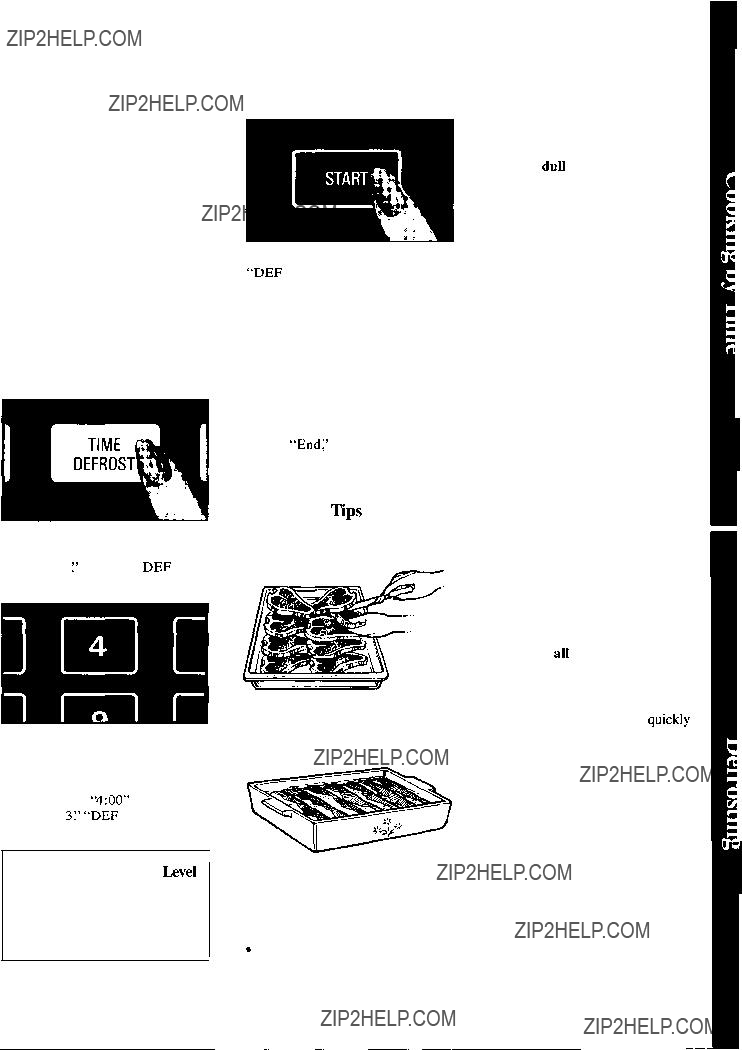
Defrosting
Time Defrost is designed for speedy thawing of frozen food and is one of the great advantages of a microwave oven.
???Power level 3 is automatically set for defrosting, but you may change this for more flexibility.
???See the Defrosting Guide for defrosting help.
To become better acquainted with the defrost function, defrost frozen pork chops by following the steps below.
Step 1: Place package of frozen chops in the oven and close door. Be sure package contains no metal.
Step 2: Touch TIME DEFROST
pad. Display shows ???: O??? and ???POWER 3 ???? ???ENTER DEF TIME??? flashes.
Step 3: Select one half of the total defrosting time recommended in the Defrosting Guide. For example, touch 4, 0 and O for 4 minutes. Display shows ???4:00??? and ???POWER 3???? ???DEF TIME??? flashes.
How to Change Power ~vel
After setting defrosting time, touch POWER LEVEL pad, then touch desired number for new power level.
Step 4: Touch the START pad. ???DEF TIME??? and time, counting down, show on the display. When cycle is completed, the oven signals, flashes ???End,??? then automatically shuts off.
Step 5: Turn package over, close door and repeat Steps 2 and 3 to set remaining half of defrosting time. Touch the START pad.
Step 6: When oven signals and flashes ???Endl??? open door, remove package and separate chops to finish defrosting.
Defrosting ~ps
. Foods frozen in paper or plastic can be defrosted in the package.
??? For even defrosting, some foods need to be broken up or separated part of the way through the defrosting time.
???
s Check the Defrosting Guide for other defrosting tips.
Questions and Answers
Q.When I touch the START pad,
Ihear a dull thumping noise. What is it?
A.This sound is normal. It is letting you know the oven is using a power level lower than 10 (High).
Q.Can I defrost small items in
a hurry?
A. Yes, but they will need more frequent attention than usual. Raise the power level after entering the time by touching the desired power level pad. Power level 7 cuts the total defrosting time about in 1/2; power level 10 cuts the total defrosting time to approximately 1/3. During either, rotate or stir food frequently.
Q. Why don???t the defrosting times in the Defrosting Guide seem right for my food?
A.These times are averages. Defrosting time can vary according to the temperature in your freezer. Set your oven for the time indicated in the Defrosting Guide. If your food is still not completely thawed at the end of that time, reset your oven and adjust the time accordingly.
Q.Should all foods be completely thawed before cooking?
A.Some foods should not be completely thawed before cooking. For example, fish cooks so quic~y
it is better to begin cooking it while still slightly frozen.
Q.Can I open the door during Time Defrost to check on the progress of my food?
A.Yes. You may open the door at any time during microwaving. To resume defrosting, close the door and touch the START pad. The oven begins operating if time is left on timer. If not, reset timer.
11

Glossary of Microwave Term
When adapting recipes for the microwave, it is best to start with a familiar recipe. Knowing how the food should look and taste will help when adapting recipes for microwaving. Foods that require browning or crisp, dry surfaces will cook better conventionally.
???Moist foods, such as vegetables, fruits, poultry and seafood, microwave well.
???Rich foods, such as bar cookies, moist cakes and candies, are suitable for microwaving because of their high fat and sugar content.
???Reduce conventional cooking time by
???Small amounts of butter or oil can be used for flavoring, but are not needed to prevent sticking.
???Seasonings may need to be reduced. Salt meats and vegetables after cooking.
Covering. In both conventional and microwave cooking, covers hold in moisture, allow for more even heating and reduce cooking time. Conventionally, partial covering allows excess steam to escape. Venting plastic wrap or covering with wax paper serves the same purpose when microwaving.
Venting. After covering a dish with plastic wrap, you vent the plastic wrap by turning back one corner so excess steam can escape.
Arranging Food in Oven. In conventional baking, you position foods, such as cake layers or potatoes, so hot air can flow around them. When microwaving, you arrange foods in a ring, so that all sides are exposed to microwave energy.
Stirring. In
Turning Over. In
Standing Time. In conventional cooking, foods such as roasts or cakes are allowed to stand to finish cooking or to set. Standing time is especially important in microwave cooking. Note that a microwaved cake is not placed on
a cooling rack.
Shielding. In a conventional oven, you shield chicken breasts or baked foods to prevent
Arcing. Sparks caused by too much metal in the microwave oven or metal touching the side of the oven or
foil that is not molded to food.
Prick Foods to Release Pressure. Steam builds up pressure in foods that are tightly covered by a skin or membrane. Prick foods, such as potatoes (as you do conventionally), egg yolks and chicken livers, to prevent bursting.
Rotating. Occasionally, repositioning a dish in the oven helps food cook more evenly. To rotate 1/2 turn, turn the dish until the side that was to the back of the oven is to the front. To rotate 1/4 turn, turn the dish until the side that was to the back of the oven is to the side.
Basic Microwave Guidelines
Density of Food. In both conventional and microwave cooking, dense foods, such as potatoes, take longer to cook than light, porous foods, such as rolls, bread or pieces of cake.
Round Shapes. Since microwaves penetrate foods to about one inch from top, bottom and sides, round shapes and rings cook more evenly. Corners receive
more energy and may overcook. This may also happen when cooking conventionally.
Delicacy. Foods with a delicate texture, such as custards, are best cooked at lower power settings to avoid toughening.
Natural Moisture of food affects how it cooks. Very moist foods cook evenly because microwave energy is attracted to water molecules. Food that is uneven in moisture should be covered or allowed to stand so heat can disperse evenly.
Piece Size. Small pieces cook faster than large ones. Pieces that are similar in size and shape cook more evenly. With large pieces of food, reduce the power setting for even cooking.
Shape of Food. In both types of cooking, thin areas cook faster than thick areas. This can be controlled in microwaving by placing thick pieces near the outside edge and thin pieces in the center.
Starting Temperature. Foods taken from the freezer or refrigerator take longer to cook than foods at room temperature. Timings in our recipes are based on the temperatures at which you normally store the foods.
Quantity of Food. In both types of cooking, small amounts usually take less time than large amounts. This is most apparent in microwave cooking, where time is directly related to the number of servings.
Shelf (on models so equipped). Use the shelf to heat more than one dish at one time. Take the shelf out when you are not using it.
12
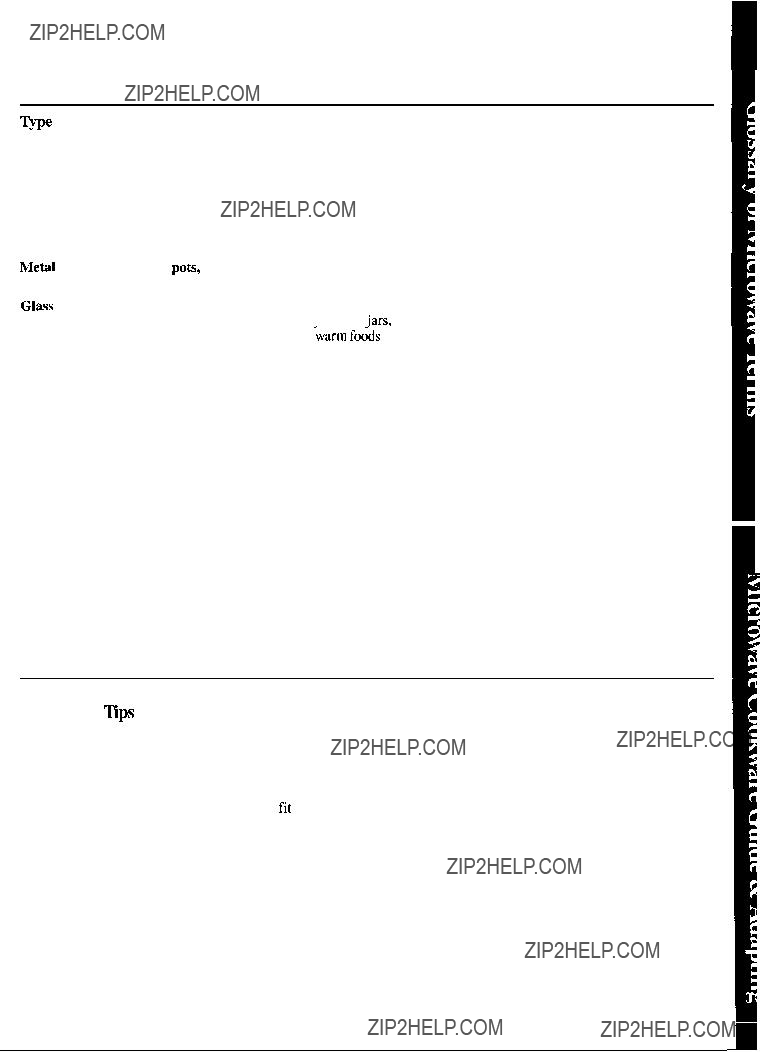
Microwave Cookware Guide &Microwave Adapting
Oven glass and ceramic
Dinnerware
Paper towels, paper napkins and wax paper
Cooking and heating.
Heating and some cooking. Follow dinnerware manufacturer???s recommendations. Avoid using dishes with metal trim.
Absorbing moisture, and preventing spatters. Heating and serving of sandwiches or appetizers. Light covering to hold in steam. Do not use paper towels that have synthetic fibers, such as nylon, woven into them. Synthetic fibers may cause the towel to ignite. Avoid using recycled paper.
Plastic wrap, cooking bags,
Paperboard trays used for frozen entrees and dinners
Plastic trays and plates used for frozen entrees and dinners
Straw, wicker and wood
Covering to hold in steam (wrap). Cooking (cooking and
Cooking and heating.
Cooking and heating.
Warming.
Cookware ~ps
???Always check the cookware manufacturer???s recommendations before using any cookware in the oven.
???Before purchasing cookware or preparing food in cookware, check its size to make sure it will fit
in the oven.
13

Heating or Reheating Guide
1. Directions below are for heating or reheating
2.Cover most foods for fastest heating. Exceptions are some sandwiches, griddle foods and baked items.
3.Bubbling around edges of dish is normal, since the center is the last to heat. Foods heated to 160??F. to 165??F. will Drovide safe. palatable results. Adjust temperatures to suit you; personal taste. Let foods stand a few minutes before serving.
4.Be sure foods are heated throughout before serving. Steaming or bubbling around edges of dish does not necessarily mean food is heated throughout.
If you use a meat thermometer while cooking, make sure it is safe for use in microwave ovens.
ItemAmountPower hvel~me
Appetizers
~p: Cover saucy appetizers with wax paper. Cover dips with plastic wrap. Microwave pastry bites uncovered to retain their crispness.
Bakery Foods
Beve~es
Gravies & Sauces
Griddle Foods
14
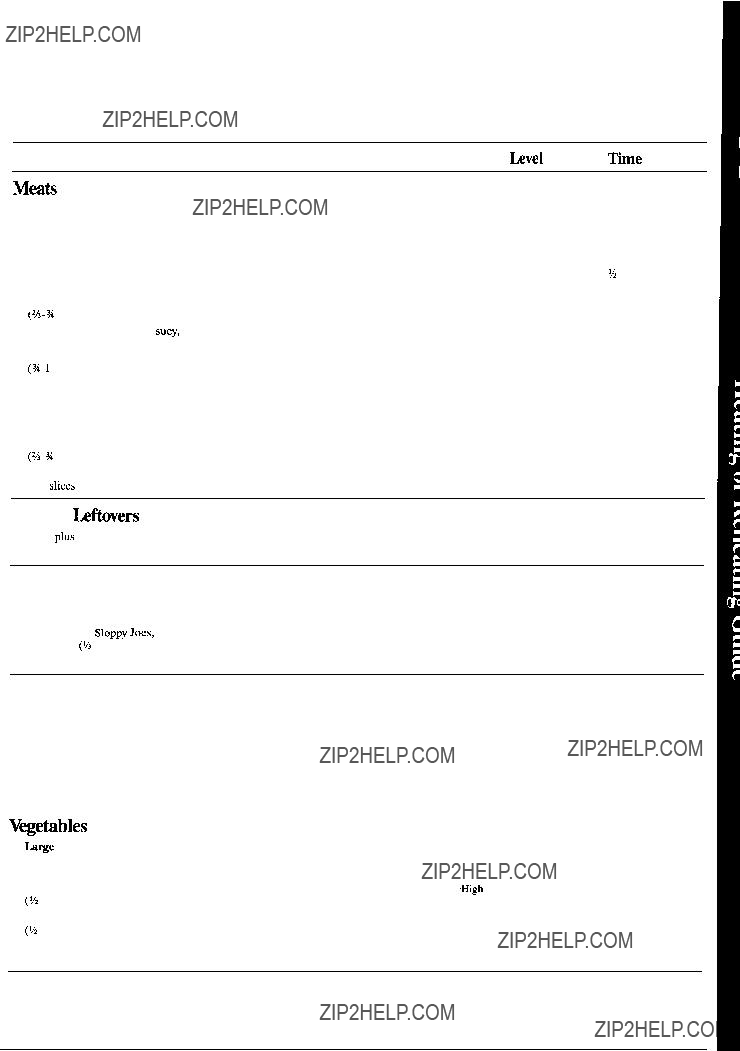
ItemAmountPower hvel=e
Mea@ and Main Dishes
Saucy, main dishes: chop suey, spaghetti, creamed chicken, chili, stew, macaroni and cheese, etc.
Tip: Cover saucy main dishes with plastic wrap. Cover other main dishes and meats with wax paper. When heating or reheating 3 to 4 servings of meat slices or pieces, rotate dish 1/2 turn after half of cooking time.
Plate of bftovers
Tip: Cover plate of food with wax paper or plastic wrap.
Sandwiches
Moist filling: Sloppy Joes, barbecue, ham salad, etc. in bun (% cup per serving)
Tip: Use paper towel or napkin to cover sandwiches.
soups
V~etibles
hrge pieces or whole: asparagus spears, corn on the cob, etc.
Mashed
(% cup per serving)
Small pieces: peas, beans, corn, etc. (% cup per serving)
Tip: Cover vegetables for most even heating.
15

Defrosting Guide
1.Food packaged in paper or plastic maybe defrosted without unwrapping. If food is foil wrapped, remove foil and place food in cooking dish for defrosting. Most food defrosts well using Defrost
(3). For more even defrosting of larger foods, such as beef, lamb and veal roasts, use Warm (l).
2.After first half of defrosting time, unwrap package and check food. ~rn food over, if necessary; break apart or separate food if possible. Shield any warm areas with small pieces of foil.
3.Be sure large meats are completely defrosted before cooking.
4.When defrosted, food should be cool but softened in all areas. If still slightly icy, return to microwave oven very briefly, or let stand a few minutes.
Breads, Cakes [Power Level: Defrost (3)]
Coffee cakes (11 to 14% oz. )
Cream or custird pie (14 oz.)
Crunch cakes & cupcakes
Doughnuts
(1 or2) (4 to 6)
fiench toast (2 slices)
Fruit or nut pie (8 in.)
Pound cake (11 U oz.)
Sweet rolls (8% to 12 OZ.)
fih & Seafood [Power Level: Defrost (3)]
Fillets:
Shellfish, blocks: Crab meat
Oysters
Scallops
Shellfish, large: Crab legs, 1 to 2 (8 to 10 OZ.)
Lobster tails, 1 to 2 (6 to 9 OZ.)
Shellfish, small pieces (1 lb.)
Steaks (6 to 12 oz.)
Whole fish (8 to 10 oz.)
16

*Use Warm (1) for roasts.
Poultry [Power Level: Defrost (3)]
Chicken,
Chicken, whole
(2]/2 to 3 Ibs.)
Cornish hen
Duckling
Turkey breast (4 to 5 Ibs.)
Place wrapped chicken in dish. Unwrap and turn over after first half of time. After second halfoftime, separate pieces and place in cooking dish. Microwave 2 to4 minutes more, if necessary. Let stand a few minutes to finish defrosting.
Place wrapped chicken in dish. After first halfoftime, unwrap and turn chicken over. Shield warm areas with foil. To complete defrosting, run cool water in cavity until giblets can be removed.
Place unwrapped hen in oven
Place unwrapped duckling in oven. Turn over after first halfoftime. Shield warm areas with foil. Run cool water in cavity until giblets can be removed.
Place unwrapped breast in
17

Cooking Guide
Breads
Crust on breads will be soft and the outsides will not brown. If
desired, sprinkle top of batter with
*If tube dish is unavailable, microwave in
Cakes and Desserts
1.Always use
2.Before adding measured amount of batter, grease dishes or line them with wax paper. (Do not flour. )
3.Cakes are done when toothpick or long skewer inserted into center comes out clean.
4.Cool cake in dish set directly on
5.Crust on cakes will be soft. If cake is to be frosted, refrigerate cake for an hour to firm exterior surface.
d Chiffon and Angel Food cakes are not recommended for microwaving.
18
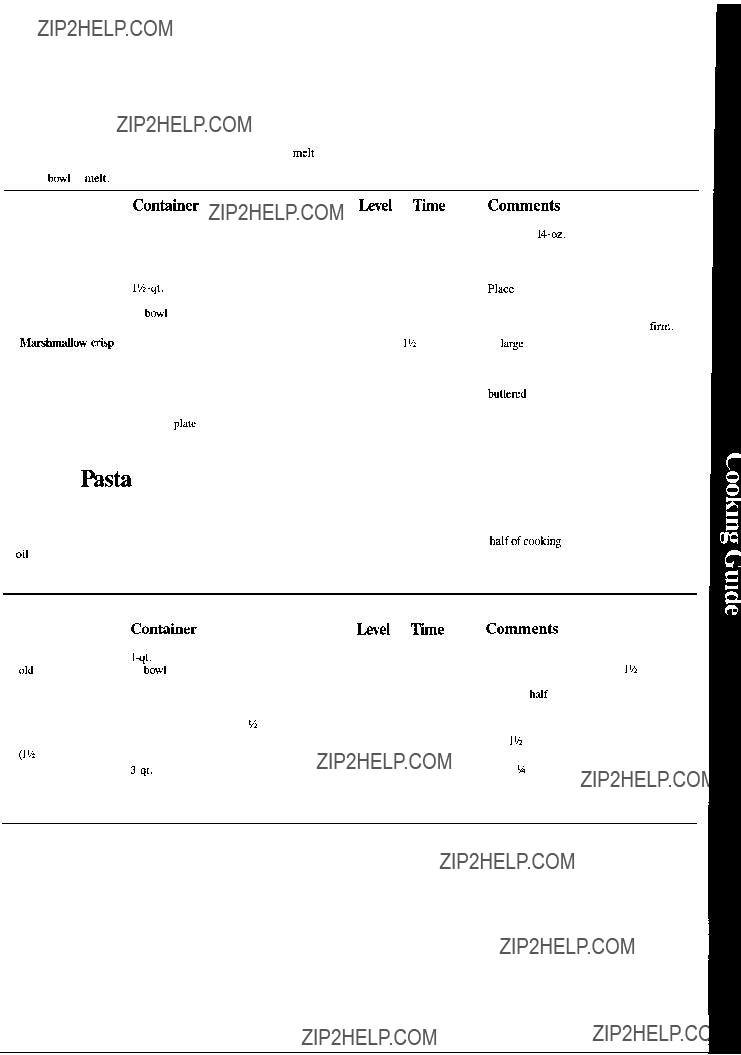
Candies
1.Always use
2.Candies which are boiled become very hot; handle cookware carefully.
Cereal, Wsb and Rice
1.Always use
2.For pasta, use about
3.For rice or minute rice, use the same amount of water needed for conventional boiling. Add regular amount of salt.
4.Cover pasta and rice while microwaving. When using plastic wrap, turn back one corner to vent.
5.Stir or rearrange after halfofcooking time. Drain pasta immediately after microwaving.
6.Microwave time and conventional boiling time are about the same.
Note: To microwave
Increase casserole size for more than one serving. Increase time about 11/2 minutes for each additional serving you are cooking. Stir after balf of cooking time.
Add 1% cups water. Stir after 2 minutes.
Add 2 K cups water. Stir after 10 minutes.
Add 6 to 7 cups water. Rearrange after 10 minutes.
19

Cooting Guide (continu~)
Cheese and EWS
1. Egs maybe prepared many ways in tbe microwave oven. Always pierce whole yolks before microwaving to prevent bursting.
2.Never cook e~s in the shell. Do not reheat hard cooked e~s in the shell. They will explode.
3.Cook egsjust until set. They are delicate and can toughen if overcookd.
FoodContiiner Cover Wwer hvel & ~me CommenG
Cheese
Puncture membrane of yolk to prevent bursting.
Sprirdde cheese over omelet. Microwave Y2 to 1 minute until cheese is slightly melted.
Heat 2 cups hot tap water 5 to 6 minutes on High (10). Break e~s onto plate, puncturing membrane. Swirl boiling water with spoon and slip in eggs gently. Cover. Microwave at Medium (5) % to 1 minute per e=. Let stand in water a few minutes.
Wh and Seafood
1.Fish is done when it flakes easily when tested with a fork. Center may still be slightly translucent, but will continue cooking as fish stands a few minutes after cooking.
2.Cook fish with or without sauce. A tight cover steams fish. Use a lighter cover of wax paper or paper towel for less steaming.
3.Do not overcook fish. Check at minimum time.
Microwave until fish flakes easily. Turn steaks over after half of cooking time.
Brush with garlic butter before cooking. Rearrange afier 4 minutes.
Place shrimp in casserole. Add 2 cups hottest tap water. Cover. Stir after 5 minutes.
20
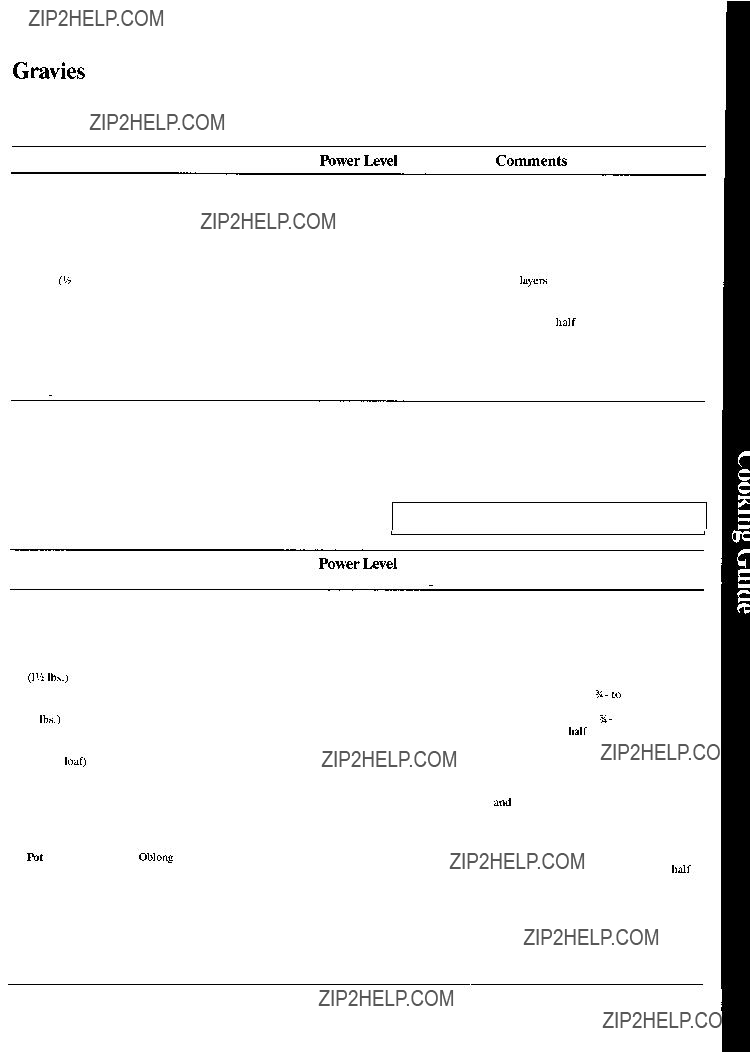
Gmvies & Sauces
1.Cover thick, chunky sauces to prevent spattering.
2.Whisk sauces vigorously with wire whisk once or twice while microwaving.
3.Vary basic white sauce by adding cheese, egg yolks, cream, wine or herbs.
Meats
1.Always use a cooking bag when cooking beef, lamb, pork or veal roasts. See package instructions for proper use of cooking bag.
2.After enclosing roast in cooking bag, place on trivet in
3.Allow about 10 minutes standing time for most roasts before carving.
If you use a meat thermometer while cooking, make sure it is safe for use in microwave ovens.
Beef
Brush with browning sauce and add 1/2 cup water to cooking bag. Turn over after half of cooking time. Add vegetables if desired after half of cooking time. Recover and finish.
21

Cooki~ Guide (continued)
Meats (continued)
Pork
Arrange in single Iayeron paper towels or on trivet set in dish. Cover with a paper towel. To microwave more than 1 layer of bacon, use an oblong dish and place a paper towel between each layer of bacon. Cover with a paper towel to prevent spatters.
Arrange in single layer.
Place
Turn over or rearrange after 10 minutes.
Brush with barbecue sauce or browning agent, if desired. Turnover after half of cooking time, Let stand covered 5 to 10 minutes before serving.
Turn roast over after half of cooking time. Microwave to an internal temperature of 170??F.
Arrange in single layer. If cooking 6 or more links, rearrange after halfofcooking time.
Arrange in single layer. Turnover after half of cooking time.
Veal
22

Poultry
Chicken
Arrange in single layer in cooking dish so thickest meaty pieces are to outside edges of dish. Turn pieces over and rearrange afier halfofcooking time.
Brush with browning agent, if desired. Slit bag near closure to vent. Close securely with plastic tie. Cook
Cornkh Hem
Vegetables
1.Always use
2.Salt vegetables after cooking. Salting before cooking may cause darkening and dehydration of surface.
3.Arrange vegetables, such as asparagus, with the thickest pieces to the outside of the dish.
4.Cover vegetables when cooking. Ifusing plastic wrap, turn back one corner to vent.
5.Lager vegetable pieces wdl take longer to cook than smaller pieces. & For more even heating, stir, rearrange or rotate vegetables during
cooking.
23

Cooki~ Guide (continued)
Vegetables (continued)
24

Care and Cleaning
Your new microwave oven is a valuable appliance. Protect it from misuse by following these rules:
. Keep your oven clean and
??? Don???t use
BE CERTAIN POWER IS OFF
BEFORE CLEANING ANY
PART OF THIS OVEN.
How to Clean the Imide
Walls and floor. Some spatters can be removed with a paper towel, while others may require a damp cloth. Remove greasy spatters with a sudsy cloth, then rinse with a damp cloth. Do not use abrasive cleaners on oven walls. NEVER
USE A COMMERCIAL OVEN
CLEANER ON ANY PART OF
YOUR MICROWAVE OVEN.
Door (inside). Window: Wipe up spatters daily and wash when soiled with a damp cloth. Rinse thoroughly and dry.
Metil and plastic parts on door: Wipe frequently with a damp cloth to remove all soil. DO N~
USE ABRASIVES, SUCH AS
CLEANING POWDERS OR
STEEL AND PLASTIC PADS.
THEY WILL MAR THE
SURFACE.
Special note when using Brown ???N Sear dish: If grease is present, high heat generated on bottom of a Brown ???N Sear dish may cause the grease to burn onto
the oven floor. This may be removed with a cleanser such as Bon Ami@ brand cleanser.
After using Bon Ami@ brand cleanser, rinse and dry thoroughly, following instructions on can. Do not use Bon Ami@ brand cleanser on the painted surfaces such as the walls. It may scratch the paint.
How to Clean the Ouhide
Case. Clean the outside of your oven with soap and a damp cloth, rinse with a damp cloth and then dry. Wipe the window clean with a damp cloth. Chrome trim is best wiped with a damp cloth and then with a dry towel.
Control Panel. Wipe with a damp cloth. Dry thoroughly. Do not use cleaning sprays, large amounts of soap and water, abrasives or sharp objects on the
Door Surface. When cleaning surfaces of door and oven that come together on closing the door, use only mild,
Power Cord. If the cord becomes soiled, unplug and wash with a damp cloth. For stubborn spots, sudsy water may be used, but be certain to rinse with a damp cloth and dry thoroughly before plugging cord into outlet.
25

The Exhaust Feature
The exhaust hood feature on your
microwave oven is equipped with two metal filters which collect grease. When the fan is operated, air is drawn up through the filters and is then discharged through the provided venting to the outside. The hood also has a light for illuminating the counter space.
To remove grease filter, grasp the ???finger hold??? on the filter and slide to the rear.
Then pull filter downward and to the front. The filter will drop out.
ro replace grease filter, slide the filter in the frame slot on the back of the opening.
Pull filter upward and to the front to lock into place.
To clean grease filter, soak, then agitate filter in solution of hot water
aid detergent. Don???t use ammonia or other alkali because they will darken metal. Light brushing can be used to remove embedded dirt.
Rinse, shake and remove moisture before replacing. Filters should be cleaned at least once a month.
Never operate your hood without the filter in place. In situations where flaming might occur on surfaces below hood, filter will retard entry of flames into the unit.
26

GROUNDING
INSTRUCTIONS
REMOVE SCREti
To replace cooktop light, first disconnect power at main fuse or circuit breaker panel or pull plug.
Remove screw on right side of light compartment cover and lower cover until it stops.
Be sure bulbs to be replaced are cool before removing. Break the adhesive seal by gently unscrewing the bulbs. Replace with
To replace your oven light, first disconnect power at main fuse or circuit breaker panel or pull plug. Remove the top grill by taking out the 2 screws that hold it in place.
Next, remove the single screw located above door near center of oven that secures light housing. Replace
Clean off the grease and dust on hood surfaces often. Use a solution of warm water and detergent. About 1 tablespoon of ammonia maybe added to the water. Take care not to touch the filters and enamel surfaces with this solution; ammonia will darken metal.
This appliance must be grounded. In the event of an electrical short circuit, grounding reduces the risk of electric shock by providing an escape wire for the electric current. This appliance is equipped with a power cord having a grounding wire with a grounding plug. The plug must be plugged into an outlet that is properly installed and grounded. (Fig. 1)
Consult a qualified electrician or service technician if the grounding instructions are not completely understood, or if doubt exists as to whether the appliance is properly grounded.
Where a standard
Do not under any circumstance cut or remove the third (ground) prong from the power cord.
Do not use an adapter plug with this appliance.
Do not use an extension cord with this appliance.

~
??? Steam or vapor escaping from
around the
c Light reflection around door or outer case.
??? Dimming oven light and change in blower sound may occur while operating at power levels other than high.
??? Dull thumping sound while oven is operating.
??? Some
If you need more help... call, toll free: GE Answer Center??? / 800.626.2000 / consumer information service
28

Notes
29

30

Wdll Be There
With the purchase of your nelv GE appliance, receive the assurance that if You ever need information or assistance ???rem GE, we???ll be??? there. N1 you have to do is
GEAnswer Center@
80&626.2W0
Whatever your question about any GE
major appliance, GE Answer CenteF
information service is avadable to help. Your
will be answered prompdy and
courteously And you can cdl any
time. GE Answer CenteP service is
Service
AGE Consumer Service professional
vfll provide expert repair service,
.cheduled at a time that???s convenient for you. Many GE Consumer Service
Service Contracts
You can have the secure feeling that GE Consumer Service will still be there after your warranty expires. Pur- chase a GE contract whale your war- ranty is stfll in effect and you???ll receive a substantial discount. With a mdtiple- year contmct, you???re assured of fiture service at today???s prices.
open 24 hours a day 7 days a week.
:lecommunication Detice for the Ded
Pam andAccesories
hdividu~ qutiled to service their own appliances can have needed parts or accessories sent direcdy to their home, free of shipping charge!
The GE parts system provides access to over 47,000 parts.. and dl GE Genuine Renewal Parts are fully warranted. WSA, Mastetiard and Discover cards are accepted.
User maintenance instructions contained in this boo~et cover p~ dms intended to be performed by any user. O*er servicing genedy shodd be refemd to qu~led ser- vice personnel. Caution must be exercised, since improper servicing
may ~use unsafe operation.
l=.:
For Customers Wfih
Special Needs...
8M.6262W0
Upon request, GE wfil provide Bratile controls for a variety of GE appliances, and a brochure to assist in planning a
Consumers with impaired hearing or speech who have access to a TDD or a conventional teletypewriter may
Cdl

YOUR GE MICROWAVE OVEN
WARRANTY
Save proof of original purchase date such as your sales slip or cancelled check to establish warranty period.
WHAT IS COVERED
FULL
For one year from date of original purchase, we will provide, free of charge, parts and service labor in your home to repair or replace any part of the microwave oven that fails because of a manufacturing defect.
LIMITED ADDITIONAL
NINEWEAR WARRANTY
For the second through tenth
year from date of original purchase, we will provide, free of charge, a replacement magnetron tube if the magnetron tube fails because of a manufacturing defect. You pay for the service trip to your home and service labor charges.
This warranty is extended to the original purchaser and any succeeding owner for products purchased for ordinary home use in the 48 mainland states, Hawaii
and Washington, D.C. In Alaska the warranty is the same except that it is LIMITED because you must pay to ship the product to the service shop or for the service technician???s travel costs to your home.
All warranty service will be provided by our Factory Service Centers or by our authorized Customer Care@ servicers during normal working hours.
Look in the White or Yellow Pages of your telephone directory for
GENERAL ELECTRIC COMPANY,
GENERAL ELECTRIC FACTORY
SERVICE, GENERAL ELECTRIC- HOTPOINT FACTORY SERVICE or
GENERAL ELECTRIC CUSTOMER
CARE??? SERVICE.
WHAT IS NOT COVERED ??? SerViCetriPStOyOurhOmetO
teach you how to use the product.
Read your Use and Care material. If you then have any questions about operating the product, please contact your dealer or our Consumer Affairs office at the address below, or call, toll free:
GE Answer Center@ 800.626.2000
consumer information service
??? Improper installation.
If you have an installation problem, contact your dealer or installer. You are responsible for providing adequate electrical, exhausting and other connecting facilities.
. Replacement of house fuses or resetting of circuit breakers.
??? Failure of the product if it is used for other than its intended purpose or used commercially.
. Damage to product caused by accident, fire, floods or acts of God.
WARRANTOR IS NOT RESPONSIBLE
FOR CONSEQUENTIAL DAMAGES.
Some states do not allow the exclusion or limitation of incidental or consequential damages, so the above limitation or exclusion may not apply to you. This warranty gives you specific legal rights, and you may also have other rights which vary from state to state. To know what your legal rights are in your state, consult your local or state consumer affairs office or your state???s Attorney General.
Warrantor: General Electric Company
If further help is needed concerning this warranty, write: